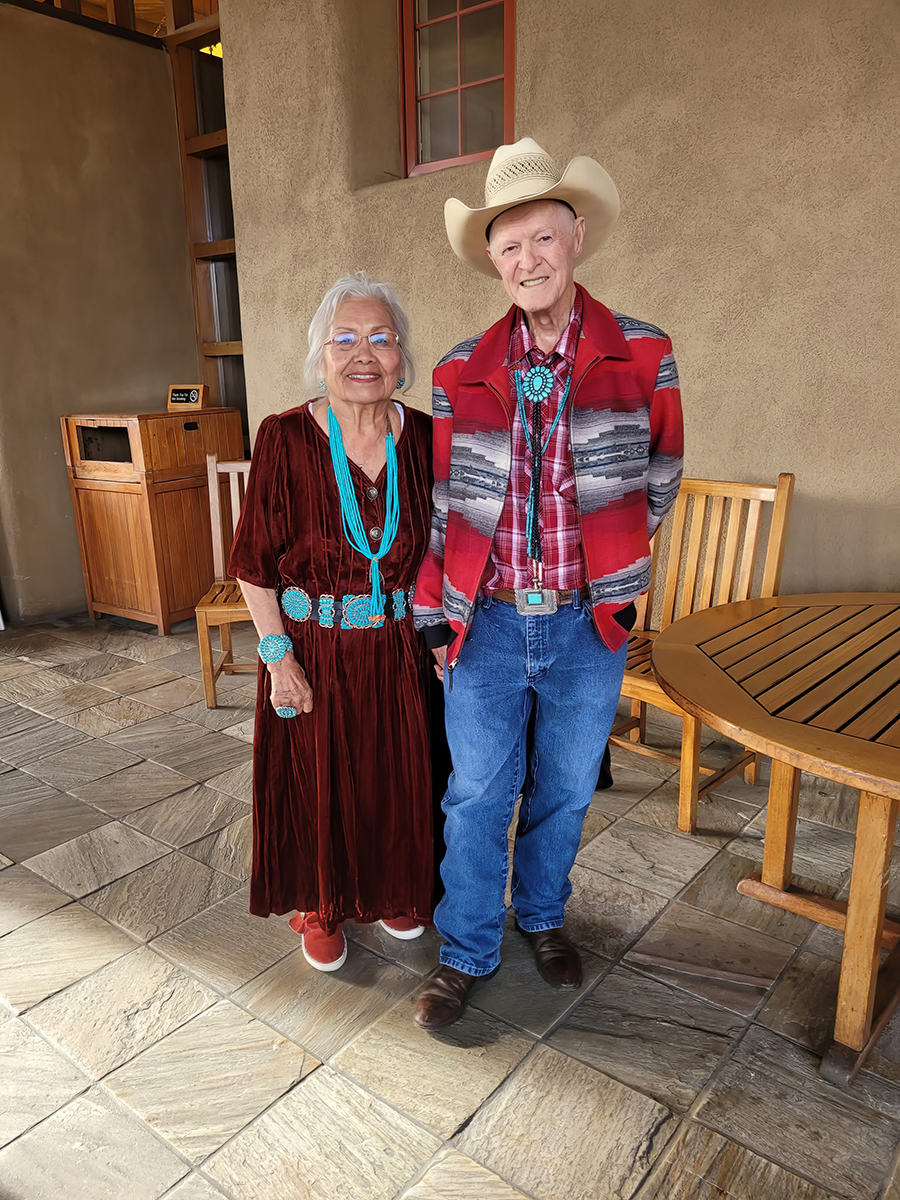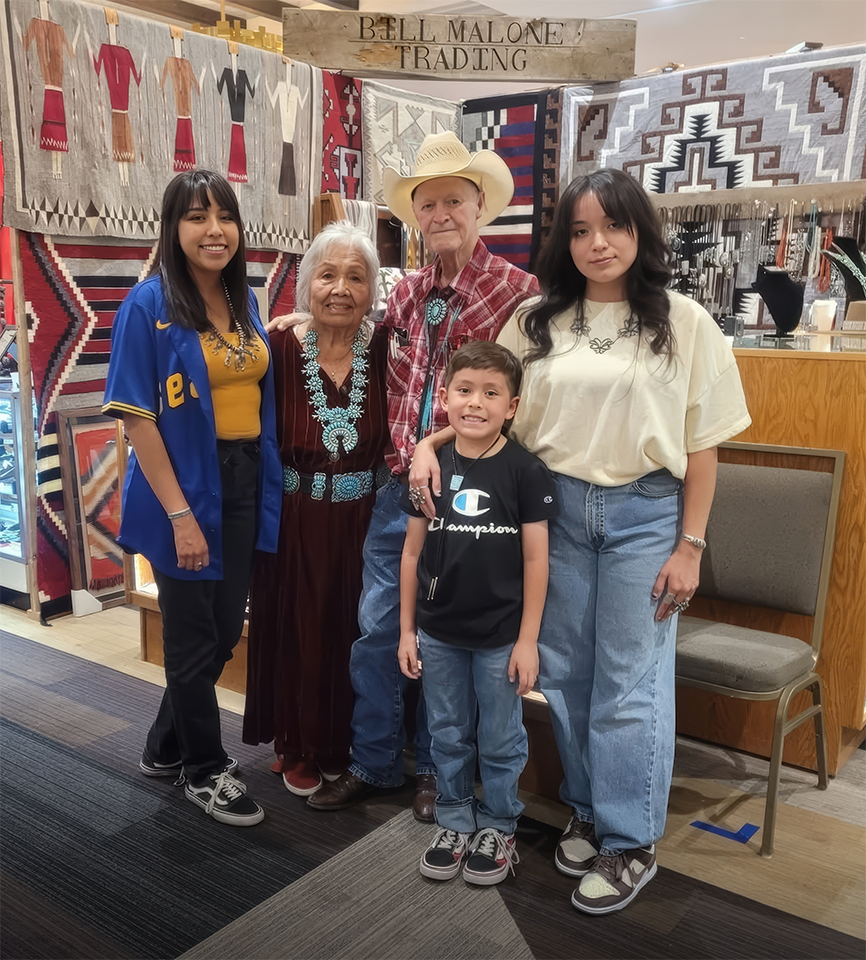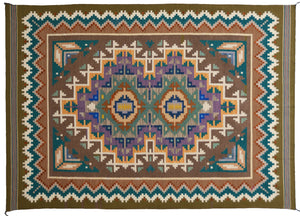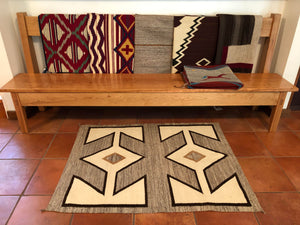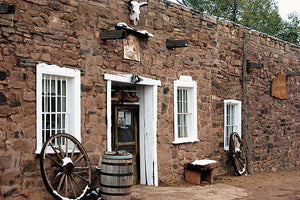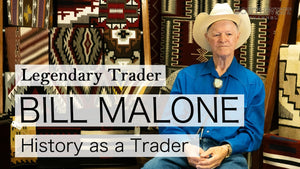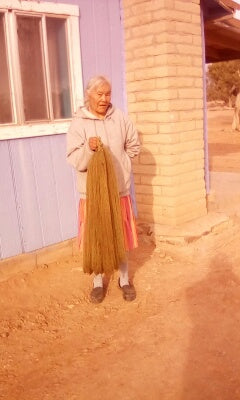Nizhoni Ranch News

2025 Gallup Inter-Tribal Indian Ceremonial Winners!
We are so happy and proud of our weavers this year. Eight out of ten weavers we entered won prizes! Congratulations!
From our entries the weavers brought home:
The Steve Getzwiller Memorial Award
2 - Best of Category
6 - 1st Place Blue Ribbons
6 - 2nd Place Red Ribbons
Award Winners - 2025 Gallup Inter-Tribal Indian Ceremonial
Teec Nos Pos Navajo Rug: Cecelia Nez : Churro 1765 :
47" x 64" (3'11" x 5'4") : SOLD
Awards: 1st Place (145) and the Steve Getzwiller Memorial Award
Burntwater Navajo Rug : Elsie Bia : Churro 1779 :
50" x 72" (4'2" x 6') : $ 9000
Awards : Best of Category and 1st Place (132)
Manta Navajo Weaving : Jalucie Marianito : Churro 1764 :
52" x 60" (4'4" x 5') : $ 14,500
Awards : Best of Category and 1st Place (150)

1st Phase Navajo Chief Blanket : Jalucie Marianito : Churro 1740 :
50" x 60" (4'2" x 5') : $ 14,500
Award : 1st Place (143)

Tree of Life : Selena Yazzie : Churro 1772 :
35" x49" (2'11" x 3'3") : $ 7,500
Award : 1st Place (161)

Innovative Design Navajo Rug : Ava Tommie : Churro 1737 :
9" x 14" (1' x 1') : $750
Award : 1st Place (196)
Three Turkey Ruin Navajo Rug : Helen Bia : Churro 1755 :
37" x 62" (3'1" x 5'2") : $ 8,000
Award : 2nd Place (122)
1st Phase Chief Blanket : Lucie Marianito : Churro 1756 :
47" x 62" (3'11" x 5'2") : $ 8,000
Award : 2nd Place ( 143)

Ganado Navajo Rug : Elsie Bia : Churro 1762 :
41" x 60" (3'5" x 5') : $ 9,000
2nd Place (143)
Two Grey Hills Variant Navajo Rug : Irene Bia : Churro 1766 : 42" x 66" (3'6" x 5'6") : $ 9,000
Award : 2nd Place (112)

Storm Navajo Rug : Geraldine Phillips : Churro 1767 :
42" x 73" (3'6" x 6'1") : $ 9,000
Award : 2nd Place (148)
Two Grey Hill Navajo Rug : Gloria Bia : Churro 1778 :
29" x 34" (2'5" x 2'10") : $ 3,500
Award : 2nd Place (101)
- Beth Barth

No More Wall Space? No Problem!
Our wonderful clients from San Antonio sent this to us:
"Finding the right place for our collection of Navajo rugs, blankets and serapes that we have purchased from your gallery over the years is not easy. I made this bench seat of cherry wood that finally works. It is 7’ wide and 30” high. I thought you would enjoy seeing how great it works as well. Do you recognize them? Many years of enjoyment".
Yes, we recognize ALL of them. What a wonderful way to display. We will mention to collectors who complain they have run out of wall space - that they might need a bench!
- Beth Barth

How Much is My Rug Worth????
Here at Nizhoni Ranch Gallery we get our fair share of inquiries about Navajo rugs people have inherited from family members. Most stories begin with something like "my grandmother bought a weaving from a trading post while vacationing in the Southwest"
The main question we are asked is "what is it worth?" The answer is: it depends... In valuing weavings we suggest keeping the following things at the forefront:
Size, Condition, Complexity of Design, Age, Tightness of weave, Types of dyes used (natural vs aniline) and provenance.
Size
Yes, size matters - a lot. Big rugs are rare which of course increases value. Past and present weavers typically weave small to medium size rugs. One reason is limited space. The larger the rug, the larger the loom. Many Navajo live in homes that have low ceilings and low square footage, which makes it nearly impossible for many weavers to take on large rugs. Another is the amount of time it takes to weave large rugs. Large rugs can take a year or more to complete. Weaver's payday typically come when they sell their rug. Which means fewer weavers then and now take on large rugs.

Condition
The condition of a Navajo Rug will of course affect the value. Pay attention to any damage, if it is clean, edges are damages, if there is any fading (one side is lighter than the other), if the wool colors have run, stains, etc. There are talented rug restores out there, yet some issues just cannot be fixed. Navajo rugs that have serious damage may not not even be worth the original cost. One rug restoration company we recommend our customers to is: Enver From Denver.
Age
1840 to 1950
Navajo rugs before the 1950's we consider historic or antique. Navajo weavings started to become popular at about the turn of the century. Navajo Textiles from 1800's have a much higher value - and they don't have to be in perfect condition!

First Phase Chief Blanket Early Classic Ute Style : 1st Phase : Historic Navajo Weaving : 51" x 68" (5'8.5" x 4'3") Call for Pricing
1940 to 1970
In mid 1900 the Southwest was all the rage. The Navajo keyed in on this and began weaving rugs for tourists. A perfect and inexpensive souvenir that could easily fit in a suitcase to take home. Navajo weavers would set up along side tourist routes. Few tourists could resist a beautiful piece of art. The weavings were small in size, designs were simple yet colorful, not always finely woven and not with the best wool. These weavings typically have a moderate value. Not necessarily a valuable family heirloom, but a warm reminder of who passed it down.
1970 to Present
Today's Contemporary Navajo rugs, can range from under $750 up to many thousands of dollars. The number of Navajo weavers working today is dwindling. Many Navajo are not learning this sacred Navajo weaving tradition, as it is a very time consuming, the pay is inconsistent and requires discipline in learning the art form.
Complexity/Tightness
There are 28+ Styles of Navajo Rugs. Some Styles are more difficult to weave than others. Complexity and tightness of the weave affect the value. Generally speaking, the tighter and finer the weave, the more valuable the piece. Teec Nos Pos is generally considered the most intricate design. 
Navajo Churro Collection, Teec Nos Pos, Geraldine Phillips, 6"1" x 12'1", Churro wool, 2015 Geraldine won Best of Category for large rugs in 2015. Churro # 1574, $18,000,
Natural Dyes vs Aniline
Using natural dyes vs aniline dyes (commercial chemical dye). Natural dyes add value because of the extra time it takes to hand dye the wool. Hand dying wool with natural dyes can take almost as much time as weaving the rug. See a previous blog we wrote on natural dyes: An Organic Experience
Provenance
Provenance is the history of the weaver and ownership of the weaving. When the history of a weaving can be verified it takes on a whole new value. The well known story of the PBS Antique Roadshow Ute blanket's provenance went all the way back to Kit Carson. A must see video from Antique Road Show - warning it is a tear jerker!
First Phase Ute Blanket, circa 1850, PBS Antique Roadshow
The Bottom Line
If you want to get an accurate value on a weaving, contact a certified appraiser that specializes in Native American art, or better yet Navajo weavings. Nizhoni Ranch does not do appraisals, as we are not certified appraisers. We suggest contacting Joan Caballero Appraisals in Amarillo/New Mexico : website http://www.collectorsguide.com/jcaballero.
Happy Trails,
Gail and Beth
Nizhoni Ranch Gallery
P.O. Box 815
Sonoita AZ 85637
Phone: 520-455- 5020
Email: nizhoniranch@gmail.com
- Beth Barth

Dye Master at Work!
Master weaver and dye artist Helen Bia was hard at work yesterday. We had the rare opportunity to see her dye in real time.

Step 1 - make the dye

Step 2 - add the wool and simmer

Step 3 - let the wool cool and sit to absorb the dye

Step 4 - check the color intensity

Step 5 - once the desired color is achieved, rinse the wool and let dry.
Making natural dyes and hand dying wool in incredibly time consuming. Very few weavers today take the extra time and effort to hand dye their wool.
It is a family tradition in certain weaving families along with "secret" family dye recipes.
Thank you Helen for giving us a glimpse into a day in the life of a Master Navajo Weaver.
Chinle : Navajo Rug : Helen Bia : Churro 1703 :
26" x 36" (2'2" x 3') : $4,000
- Beth Barth

Churro Sheep : Back from the Brink!
For hundreds of years Churro sheep have been the center of Navajo life, yet the animal was nearly exterminated by outside forces.
Steve started working with Navajo weavers in the early 1970s and in the 1980s. He was very interested in improving the Navajo weaving quality by distributing better wools to some of his better weavers. During this time it was New Zealand Romney and Lincoln wools he would distribute to some of the better weavers in the Wide Ruins and surrounding areas. Many of these works were featured in his book The Fine Art of Navajo Weaving.
In the 1990s the economy was not very good and the natural dyes of the Wide Ruin weavers were copied commercially so the uniqueness of their weavings was compromised in value. At this time, Navajo weavings were missing something. Steve met with an old friend, Ray Dewey, in Santa Fe and they discussed how the quality of Navajo weavings could be improved at this point in time. The answer was the wool and the dyes.
The best weaving wool for the Navajo rugs and blankets is the Churro sheep wool. The historic pieces that have been present since over 100 years ago are clear evidence that the Churro wool is the best and only becomes better with time. This conclusion planted the seed to bring Navajo churro wool back to the loom. There were existing efforts to revive the Churro sheep since it was on the endangered species list, but nothing to improve genetics enough to have a high quality weaving wool. Navajo churro wool was the first weaving wool of the Navajo Nation because of its low lanolin content, long staple and translucent qualities. Bringing the churro sheep back to the Navajo weaver and the wool back to the loom was an important goal for Steve and Gail.
Steve was able to find the source of the Navajo Churro Reg
- Beth Barth

The Start! We are in the early stages of creating a film of our Navajo weavers and the Navajo Nation!

Left to Right: Lori Cummings, Daisey James, Elsie Bia and Gail Getzwiller in Canyon de Chelly at Spider Rock.

Left to Right: Steve Wood, Lori Cummings, Gail Getzwiller and Jeff Voracek at the Historic El Rancho Hotel in Gallup NM.

Left to Right: Jeff Voracek and Berlinda Nez Barber at Bill Malone Trading.


Kathy Marianito (91 years old!) at her loom. October 2024

Left to Right: Judy, Jamie, Jalucie, Sean, Laverta, Kathy and Lucie Marianito. Jeff Voracek and Steve Wood in the rear, on the Navajo Nation.
- Beth Barth

Navajo Rugs Have Transformed My Home
The first thing I would say is everyone who comes into the home and sees the large Navajo rug in the living room remarks that this single item has transformed the way the whole house looks - and without me soliciting comments! The next thing I notice is that most of the time they suddenly sit down on the sofas and just start remarking how much this one large rug has enhanced the beauty of the living room! Many have remarked that the Navajo rug I chose from yall for this room even matches the stonework colors in the living room! Truthfully I never had anyone remark about the Costco rug I had in this room ever! And I give yall all the credit for the real life photography on your website which enabled me to make the decisions. I had no idea this would elicit so many comments.
The Navajo rugs I have purchased from you have really transformed the comfort and beauty level in my opinion of this nice house in a gated community here in Austin. Another interesting observation is how my cocker spaniel Rocky likes all of the Navajo rugs I have purchased from you - and how he seems to claim them!! When he is in the office looking out and being the watch dog he is, he puts his well fed rear end right on the Navajo rug - and not the wooden flooring anymore!
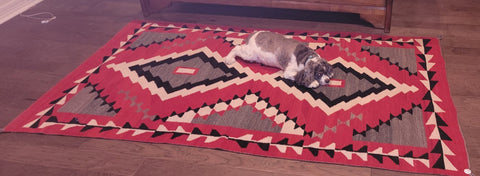
So that is testimony number 2 for my observations of this dogs' reaction to his new "purchase" from yall.
The beautiful Navajo rugs I have purchased from you are in 5 words - beautiful, transformational, worth the money (in my opinion)! And I might add the Navajo rug I purchased from you for the room I use as an office in the front part of the house has made me totally 'unclutter' this room because I like the look and 'feel' of this room so much more now because of this beautiful Navajo rug from yall.
Thanks again.
Dale in Austin Texas
- Beth Barth

Highlighting the Incredible Weaver Berlinda Nez-Barber
Master Weaver: Berlinda Nez
From: the Shiprock Area of the Navajo Nation
CLAN: “Where Water Meets Born for Tangle” Clan and “Bitter Water” Clan, Her Nali is Comanche Warrior.
Berlinda started Weaving in summer of 1990 when she was 14 years old. She was taught by her Mother, Grace Nez. Berlinda’s weavings have been in several exhibitions at the Desert Caballeros Western Museum in Wickenburg, AZ.
Berlinda is from the famous and talented Nez family. Her mother Grace and 7 sisters are all award winning and highly respected Master Weavers. Berlinda, “I have no favorite styles of weaving, they all turn out wonderful and incredibly beautiful. Weaving is hard and takes a lot of thought and time, you need time! But weaving is also a lot of fun!”
Berlinda says, “I think the most exciting part of my work is when a weaving is completed. You look at the work done and know that I did that! The rugs are beautiful, they always are. My mom, Grace Nez, was always my influence and my sister Lena too, because they did and do large rugs. My sister Helene is also an inspiration to me because she does sandpainting rugs. There are designs I would still like to weave, yes. I moved off the Navajo Reservation for 12 years and then moved back. I have a family of my own and hope to weave more now and see some of my designs come to life.”
Below are weavings by Berlinda that are currently available.

Teec Nos Pos Navajo Rug : Berlinda Nez Barber : Churro 21 : 72" x 120" (6' x 10') $ 30,000
This weaving is woven with wool dyed that used all natural dyes! This weaving has been tucked away in the Getzwiller personal collection, as many of the Nez pieces have, since it was finished in 1996. It is time for this piece to grace the home of a new owner.

Night Sky Yei be Chei Pictorial Navajo Weaving : Berlinda Nez Barber : Churro 227 : 48" x 105" (4' x 8'9") : $ 27,000
Berlinda started this weaving July 1998 and finished Jan 2000 : 1 1/2 years on the loom. It is woven so tightly, it is difficult to even run a needle through it. This weaving has been tucked away in the Getzwiller personal collection, as many of the Nez pieces have, since it was finished in 2000.

Teec Nos Pos / Red Mesa Navajo Rug : Berlinda Nez Barber : Churro 1716 : 30.5" x 45.5" (2'6.5" x 3'9.5") $ 5,000
2023 Gallup Inter-Tribal Indian Ceremonial Award Winner!
It has been many years since we have had a rug from Berlinda. She completed this one in early 2023. SOLD
- Beth Barth

August 17th
National Nonprofit Day, recognized in America on August 17, raises awareness of charitable contributions from nonprofit groups across the world. The awareness day followed the 1894 Tariff Act that introduced the first federal tax exemptions for nonprofit organizations.
Please consider supporting our non-profit.
Forever Navajo - Supporting Navajo Weavers
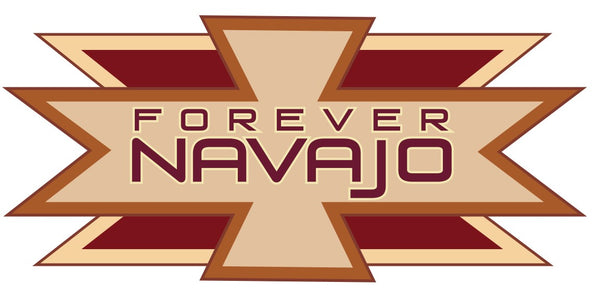
FOREVER NAVAJO is a 501(c)(3) organization founded by Steve and Gail Getzwiller to help the Navajo weaver and keep the Navajo Weaving Tradition alive.
OUR MISSION: TO ENSURE THE ADVANCEMENT AND SURVIVAL OF THE UNIQUE INDIGENOUS WEAVING ART FORM OF THE NORTH AMERICAN NAVAJO NATION, NAVAJO WEAVING.
The Primary Purpose of Forever Navajo is to Preserve the Fine Art of Navajo Weaving through
* Educating the public about the Navajo weaver and Navajo weaving
* Sponsor/funding documentaries, films, articles, books, lectures about Navajo weaving
* Work with other foundations or organizations to deliver assistance to Navajo weavers
* Sponsor/fund Navajo weaving workshops
Nizhoni Ranch Gallery gives a percentage of each sale to the Forever Navajo Foundation
To Donate: checks can be written to FOREVER NAVAJO
and mail to : FOREVER NAVAJO
P.O. BOX 815
SONOITA AZ 85637
INFO@FOREVERNAVAJO.ORG
520-455-5020
501C3 NON-PROFIT - EIN: 82-5231532
- Beth Barth














